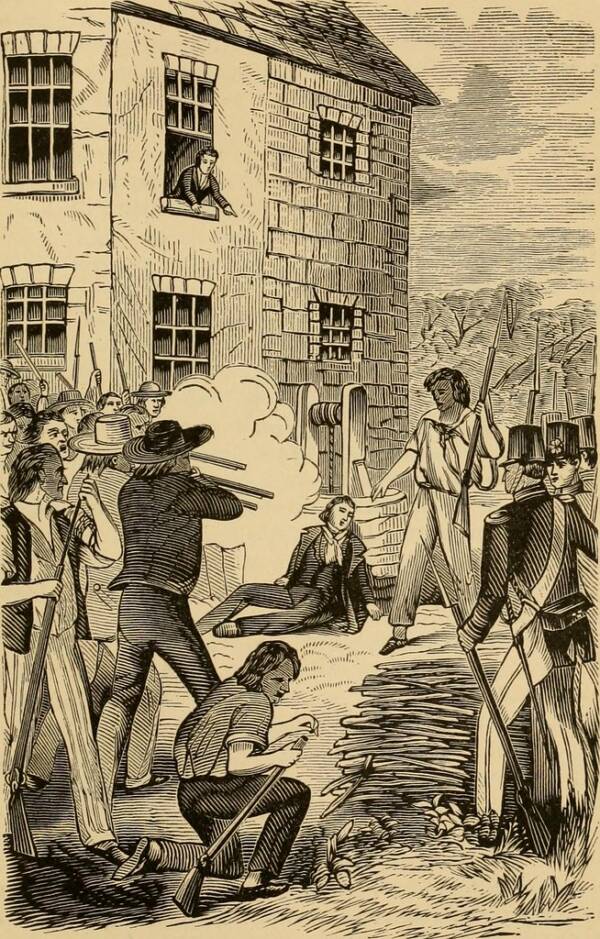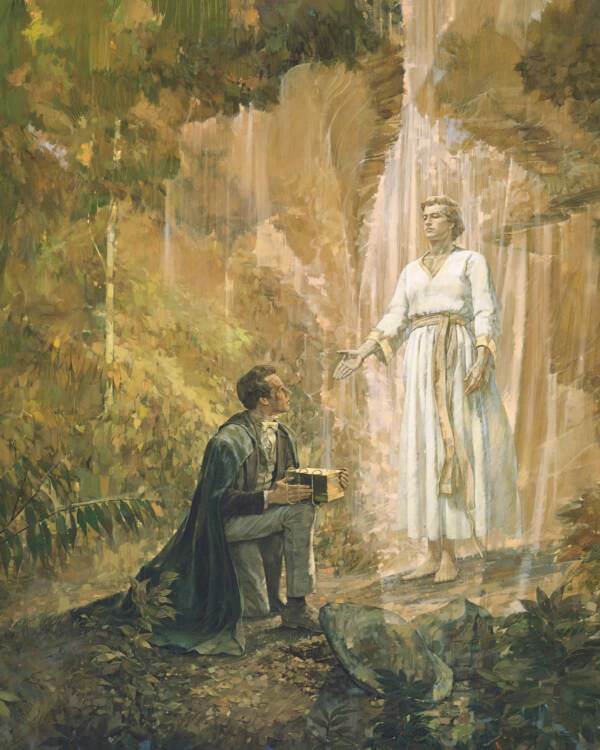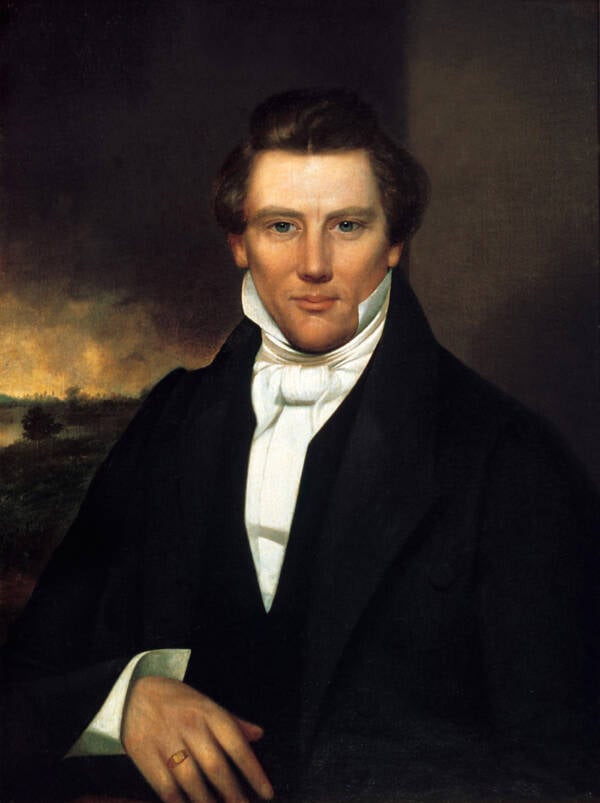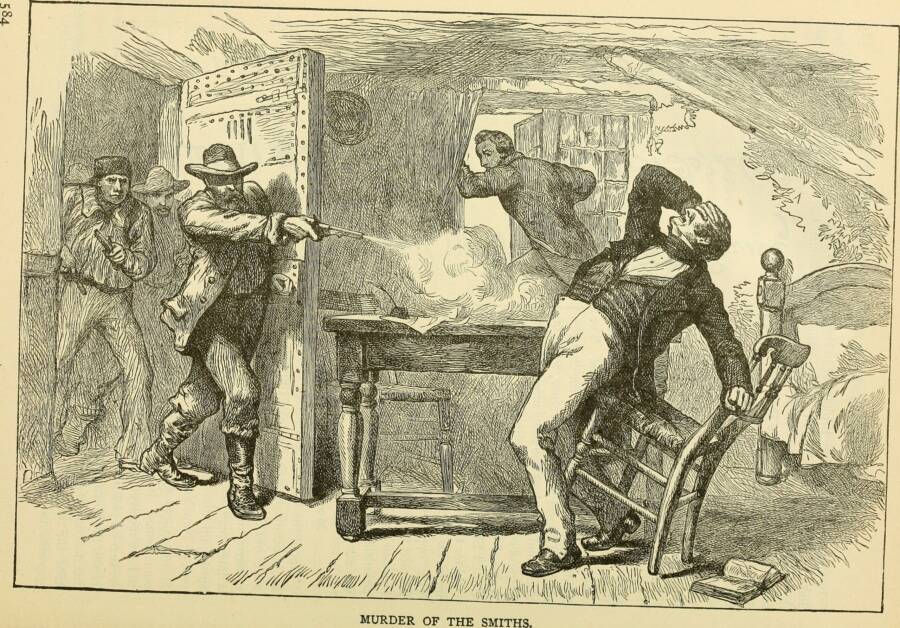When Joseph Smith was killed in Illinois on June 27, 1844, it marked a dramatic conclusion to his controversial life and profoundly impacted the future of the Mormon Church.

Public DomainJoseph Smith’s death in June 1844 changed the course of Mormon history.
By the time Joseph Smith died at the hands of an angry mob in 1844, he’d become a polarizing figure. The founder of the Church of Jesus Christ of Latter-day Saints, Smith courted controversy both inside and outside of Mormonism, controversy which had intensified in his final years.
By then, cracks had started to emerge from within the Mormon church. Smith had successfully started his religion — based on a 588-page volume called the Book of Mormon which he claimed to have produced at the request of an angel — but some of his followers took issue with his leadership style.
In 1844, a group of dissenting church members started publishing a newspaper in the city of Nauvoo, Illinois, where Smith and his followers had settled after being chased out of other towns. They accused Smith of practicing polygamy and harshly critiqued him as a would-be king.
Smith declared martial law and ordered the press destroyed. But his actions roused the ire of Illinois politicians, including Governor Thomas Ford, who charged Smith and his brother with treason. They were brought to jail in Carthage, where an angry mob started to gather like an incoming storm.
It wasn’t long before Joseph Smith died a violent death at their hands. But for many Mormons, Smith’s violent death in Carthage was not an ending — but instead a new beginning.
The Birth Of The Church Of Latter-Day Saints
Born on December 23, 1805, in Sharon, Vermont, Joseph Smith Jr. grew up in a religious atmosphere electrified by the Second Great Awakening, a period of Protestant religious revival across the nation. After moving to New York as a boy, Smith began to wonder which branch of Christianity was “correct.”
Smith claimed that God gave him an answer in 1820 — none of them. As Robert Remini explains in his 2002 book Joseph Smith, the Mormon leader later avowed that God had visited him and told him that all Christian denominations had “turned aside from the gospel.”
Three years later, Smith allegedly had a second divine visit, this time from an angel named Moroni. According to Encyclopedia Britannica, Moroni reportedly told Smith about a lost holy text inscribed on gold plates and buried nearby, which he instructed Smith to find and translate.

Book of Mormon Central Joseph Smith claimed that the angel Moroni provided him with golden tablets that detailed new revelations about Christ.
Smith found the text and spent the next 90 days “translating” it. He published it in 1830 as a tome called the Book of Mormon, the same year that Smith founded the Church of Christ (later called the Church of Jesus Christ of Latter-day Saints).
Soon, Smith’s church began to grow. But he and his followers faced persecution wherever they went. In Ohio, Smith was beaten unconscious, tarred, and feathered, and a mob once tried to get him castrated. In Missouri, tensions between Mormons and Missourians grew so bitter that the governor ordered that Mormons be “exterminated or driven from the state.”
By 1839, however, the Mormons seemed to finally find safe haven when they settled in the town of Commerce, Illinois, which Smith soon renamed Nauvoo (a Hebrew word for “beautiful place”). But there, tensions within the Mormon church itself would soon lead to Joseph Smith’s death.
Joseph Smith’s Death At The Hands Of An Angry Mob
By 1844, Nauvoo almost rivaled Chicago in size. This population boom made many non-Mormons nervous, especially when Joseph Smith announced his intentions to run for president that year. The Mormon leader made no secret of his overarching ambition. “I intend to lay a foundation that will revolutionize the whole world,” he declared, according to PBS.

Public DomainPortrait of Joseph Smith, founder of the Church of Latter-day Saints, circa 1842.
But while Smith’s political aspirations rattled non-Mormons, many Mormons had also started to take issue with Smith’s leadership. Dissidents within the Church of Latter-Day Saints published a newspaper critiquing Smith’s polygamy as well as his leadership style.
Smith had the press destroyed, which outraged many of his critics. To quell the violence, Smith then declared martial law, but this only aroused the ire of local authorities, who charged him with treason and conspiracy. Upon his arrest, Smith prophetically remarked that he would not survive long.
“I am going like a lamb to the slaughter,” he declared according to the Church of Latter-day Saints, “but I am calm as a summer’s morning; I have a conscience void of offense towards God, and towards all men. I shall die innocent, and it shall yet be said of me — he was murdered in cold blood.”
On June 25, 1844, Joseph Smith and his brother Hyrum were taken to jail in Carthage along with several of their followers. Just two days later, a mob enraged by the growing political power of Mormons, and by Smith himself, stormed the prison. Armed, and with faces painted black, they quickly made it to the Mormons’ cell and released a hail of bullets, killing Hyrum.

Public DomainJoseph Smith died in Carthage, Illinois, alongside his brother, Hyrum, after an angry mob stormed the prison where they were being held.
Smith was also hit four times but managed to make it to the second-story window. He fell to the ground outside where Smith — perhaps still alive — was propped up against the wall and shot at again. Joseph Smith died at the mob’s hands, but the church that he’d founded didn’t die with him.
The Lasting Effect On The Mormon Church
Joseph Smith’s death did not bring peace to Illinois. On the contrary, the Mormons were more persecuted than ever, as angry mobs burned their homes and threatened more violence. Though five members of the mob were indicted for killing Smith and his brother, they were later acquitted.
Given the conditions in Nauvoo, Smith’s successor, Brigham Young, decided that the city was no longer safe. On February 10, 1846, Young headed west with 1,600 Mormons in search of a new place to settle. After a difficult journey, he and his followers arrived in the Salt Lake Valley in present-day Utah where, according to HISTORY, Young declared: “This is the place.”
Thousands of Mormons poured into the territory. By the time Young himself died in 1877, more than 100,000 people had settled there, mostly members of the Church of Latter-day Saints.

Public DomainAfter Joseph Smith’s death, Brigham Young took over as leader and led hundreds of Mormons to Salt Lake City, Utah. Here, Young is seen in 1855.
As time went on, the Mormon community grew and thrived. To this day, Salt Lake City remains the headquarters of the Church of Latter-day Saints, and the church has more than 16 million members across the world.
And Joseph Smith, the church’s founder, is far from forgotten.
After learning the true story behind Joseph Smith’s death at the hands of an angry mob, read about the dark history of Mormonism. Then, read about the Mormon underwear known as the temple garment.





